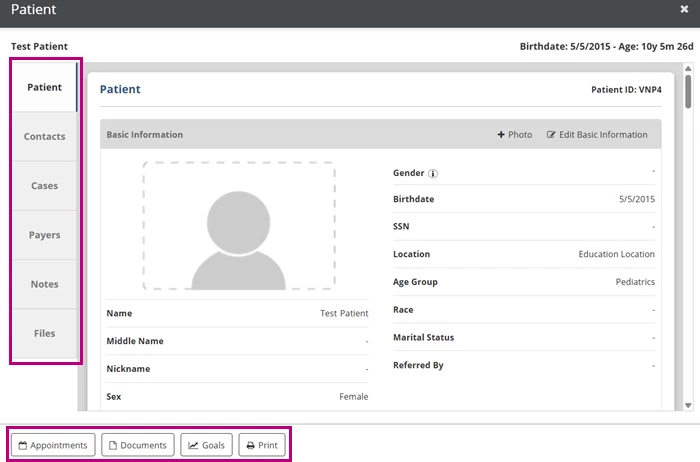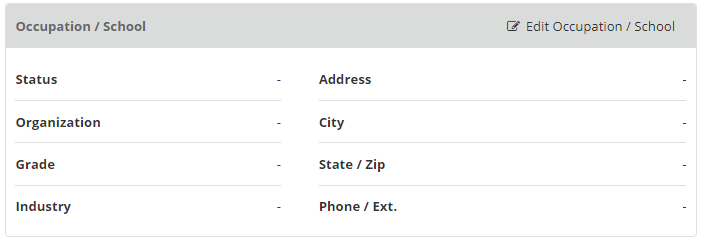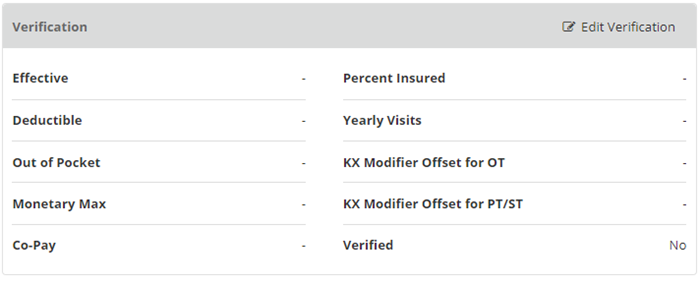PERMISSIONS REQUIRED: Your permissions, locations and/or scheduled appointments will determine the patient charts you have access to.
Document basic patient information, contacts, therapy and diagnosis details, and payer and guarantor information in the patient chart. Because information from the patient chart pulls directly into the CMS-1500 Claim Form, it's important to make sure information in the patient chart is entered correctly to avoid claim rejections.
There are multiple ways to access a patient's chart. You can use the Search Patients field in the top left corner to search for a patient using the patient name, birthdate, or the phone number of a patient contact. You can also open a patient chart by hovering over an appointment on the schedule and clicking the View Patient icon. If you are an administrator, you can also access any patient chart from the Patient List.
The Patient Chart is organized by the Patient, Contacts, Cases, Payers, Notes and Files tabs on the left side of the chart. Click any tab to jump to that part of the chart, or use the scroll bar on the right to navigate through the chart. You can also use the buttons at the bottom of the chart to view additional patient information.
- Click the Appointments button to View a List of a Patient's Appointments.
- Click the Documents button to view the patient's completed documents.
- Click the Goals button to view the patient's goals. Administrators can also add goals for other therapists' patients and other service types from here.

The sections below contain more information about documenting in the Patient, Contacts, Cases, Payers, Notes and Files tabs in the patient chart.
Jump to Section:
Patient
The Patient Tab has sections for documenting basic information about the patient, their therapy and medical details, occupation or school, patient notes, and patient alerts. Click the Edit button in the upper right corner of each section (or click anywhere inside of the section) to edit that section, then when you're finished, click the Save button in the upper right corner.
Basic Information
Basic Information entered in this section will pull into patient claims.
| Field | Description |
|---|---|
| Name | The patient's name is used on documentation and claims. |
| Middle Name | The patient's middle name. |
| Nickname | The name the patient goes by is displayed instead of the patient's first name in some places. |
| Sex | The sex the patient was assigned at birth. This pulls into claim forms and should match what is on file with the patient's payers in order to avoid claim rejections. |
| Gender | The patient's gender. This field does not pull into claim forms, so you can enter your own text here. The drop-down will display text that was entered for other patients. |
| Birthdate | The patient's date of birth. |
| SSN | The patient's social security number. |
| Location | The patient's primary clinic location will help determine which users have access to the patient. |
| Age Group | Indicates whether the patient is in the pediatric or adult age group. |
| Race | The patient's race. |
| Marital Status | The patient's marital status. |
| Referred By | Indicates how the patient was referred to the clinic. |
Therapy / Medical Details
Therapy/Medical Details entered in this section are usually only necessary when workers compensation or an auto accident is involved in the patient's diagnosis. Check with your Payer to see if a KX Modifier is required to submit the claim.
| Field | Description |
|---|---|
| Medical Record | The patient's medical record number. |
| Reference # | The patient's reference number. |
| Generate Claims | Determines whether or not claims are automatically created for this patient when charges are submitted through a daily note. Automatic claims must also be enabled on the patient's payers. See Add & Manage Payers for more information. |
| KX Modifier | Turn on the KX Modifier to automatically apply it to all of this patient's OT or PT/ST claims. |
| Work Accident | Indicates whether or not therapy services are needed due to a work-related accident, which affects box 10a on claims. |
| Auto Related | Indicates whether or not therapy services are needed due to an auto-related accident, which affects box 10b on claims. |
| Other Accident | Indicates whether or not therapy services are needed due to another type of accident, which affects box 10c on claims. |
| Accident Date | The date of the indicated accident. |
Occupation / School

| Field | Description |
|---|---|
| Status | The patient's employment or student status. |
| Organization | The name of the patient's school or place of employment. |
| Grade | The patient's grade level. |
| Industry | The industry the patient is employed in. |
| Address | The address of the patient's school or place of employment. |
| Phone / Ext. | The phone number of the patient's school or place of employment. |
Patient Notes
Use Patient Notes to record any general notes about the patient.
Patient Alerts
Patient Alerts will display on all patient appointments. You can create Patient Alerts to highlight important information like allergies or custody information.
Contacts
The Contacts Tab has a section to document a primary contact for the patient and a section to indicate who can access the patient portal. To add an alternate contact, click the + Contact button. To change a contact to the patient's primary contact, click the Make Primary button.
Primary Contact
The Primary Contact may be the patient or a caregiver. Click the Edit Primary Contact button in the upper right corner (or click anywhere inside of the section) to edit primary contact information, then when you're finished, click the Save button in the upper right corner. Click the Invite to Portal button to invite the contact to access the patient portal.
| Field | Description |
|---|---|
| Full Name | The contact's full name. If this information is about the patient, leave this field blank. |
| Address | The contact's address. |
| The contact's email address. | |
| Reminders | Enable email or text appointment reminders for the patient's upcoming appointments for patients and their caregivers. You must obtain consent before sending Text Appointment Reminders. See Set Up Appointment Reminders for a Patient for more information. |
| Phone # | The contact's primary phone number. |
| Phone Note | A note about the contact's primary phone number. |
| Cell # | The contact's cell phone number. This is the number used for text reminders. |
| Cell Note | A note about the contact's cell phone number. |
| Emergency # | The contact's emergency phone number. |
| Emergency Note | A note about the contact's emergency phone number. |
Portal Users
The Portal Users section displays a list of portal users who can access the patient's information via the patient portal. You can Invite Contacts to the Patient Portal or Remove a Portal User's Access from here.
Cases
The Cases Tab displays each Patient Case that is associated with the patient. From here, you can view and edit existing patient cases, including the diagnosis associated with each case, Add a New Patient Case to the Patient, delete a patient case, and view a patient's discharged cases. A patient may have one or more cases, but the therapist viewing the chart will only see the patient cases that are associated with their service type. The name of the patient case will display at the top of the patient case on the left side, above the case information.
NOTE: When Patient Cases was released, the system automatically created default Patient Cases for each service type that your clinic was using at the time of the release. Existing patients also had their therapy data converted into Patient Cases for those service types.
- Click the Edit Case button in the upper right corner of an existing Patient Case (or click anywhere inside of the Patient Case) to edit therapy details and diagnosis, then when you're finished, click the Save button in the upper right corner.
- Click the Delete button on a Patient Case to delete that case. You can delete a patient case as long as no documentation or appointments have been created for that case.
- Click the View Physician button on a Patient Case to view the name, contact information, practice information and other details for the referring physician associated with the Patient Case.
- Click the +Diagnosis button on a Patient Case to add a diagnosis to that case.
- Click the +Case button at the top of the Patient Cases tab to Add a New Patient Case to the Patient.
-
Click the Discharged toggle to view Discharged Patient Cases. (The Cases tab will default to display Active Patient Cases.)
| Field | Description |
|---|---|
| Referring Physician | The Referring Physician for the case. The Referring Physician pulls into Box 17 on claim forms. |
| Ordering Provider | The Ordering Provider for the case. The Ordering Provider will be included in electronic claim submissions even if it does not appear on the claim form. It will also pull into Box 17 on claim forms if a case has no Referring Physician. |
| Visit Frequency | The frequency of the patient's treatment sessions, which appears on evaluations, progress notes, re-assessments, and discharges. |
| Therapy Duration | How long the patient will receive treatment, which appears on evaluations, progress notes, re-assessments, and discharges. |
| Rx Expiration | When the patient's Rx or referral expires, which can generate Rx Expiration Reminders. |
| Start of Care | When the patient's therapy services began. |
| Last Assessment | The date of the patient's last evaluation or re-assessment, which can generate Documentation Reminders. |
| Last Progress Note | The date of the patient's last progress note, which can generate Documentation Reminders. |
| Diagnosis | The patient's diagnosis code that is relevant to their treatment for this service type. |
| Onset | The date the patient was diagnosed or when they began exhibiting difficulty. |
Payers
Use the The Payers Tab to add and manage multiple payers with associated effective dates and cases. Payer information from this section pulls into claims.
Payer Summary and Basic Information
The Payer Summary table at the top of the section provides an overview of the patient’s current payers. To select a new payer for the patient, navigate to the Payers tab, then click + Add Payer. Details for the selected payer display in the Basic Information section below the Payer Summary.
Learn more: Manage your Patient’s Active Payers & Insurance History

Guarantor
The system automatically populates the Guarantor fields with the patient's information. The Relationship to Patient field defaults to Self and the patient's contact information pulls in to the other fields. If the Guarantor is someone other than the patient, click the Edit Guarantor button to enter their information here. Use the Relationship to Patient drop-down menu to select the appropriate relationship the guarantor has to the patient, then fill in the rest of the guarantor's information and click Save.
| Field | Description |
|---|---|
| Relationship to Patient | The guarantor's relationship with the patient, which affects box 6 of the claim form. |
| Name | The guarantor's name, which can appear on claims. If Relationship is "Self", this is the patient's name. |
| SSN | The guarantor's social security number. If Relationship is "Self", this is the patient's SSN. |
| Sex | The guarantor's gender, which can appear on claims. If Relationship is "Self", this is the patient's Sex. |
| Birthdate | The guarantor's date of birth, which can appear on claims. If Relationship is "Self", this is the patient's Birthdate. |
| Address | The guarantor's address, which can appear on claims. If Relationship is "Self", this is the primary contact's Address. |
| Phone | The guarantor's phone number. If Relationship is "Self", this is the primary contact's Phone. |
| Organization | The guarantor's organization. If Relationship is "Self", this is the patient's Organization. |
Verification

| Field | Description |
|---|---|
| Effective | The date range that the patient's coverage has been verified for. You can create Verification Reminders for when the end date is approaching. |
| Deductible | The patient's total and remaining deductible amount for this payer. These amounts do not automatically change. |
| Out of Pocket | The patient's total and remaining out-of-pocket maximum for this payer. These amounts do not automatically change. |
| Monetary Max | The patient's total and remaining monetary maximum for this payer. These amounts do not automatically change. |
| Co-Pay | The patient's expected co-payment for this payer. |
| Percent Insured | The percentage this patient is insured for. |
| Yearly Visits | The maximum number of yearly visits the patient is covered for. |
| KX Modifier Offset for OT | The amount the payer has paid for relevant OT services outside of the system, such as payments made to another provider in the calendar year. This will adjust when a reminder for the KX modifier appears. Administrators can set up KX Reminders. |
| KX Modifier Offset for PT/ST | The amount the payer has paid for relevant PT/ST services outside of the system, such as payments made to another provider in the calendar year. This will adjust when a reminder for the KX modifier appears. Administrators can set up Administrators can set up KX Reminders. |
| Verified | Indicates whether or not the patient's coverage information has been verified for the effective dates. |
Eligibility Requests
If your clinic is Enrolled in Eligibility Requests, the patient chart will have a section where you can View Eligibility Request Results.
Coverage Notes
Use Coverage Notes to record notes about the patient's coverage.

Third-Party Liability Codes
Some payers may assign patients a Third-Party Liability code (or Carrier code) that needs to be used instead of the previous payer's normal ID when submitting a secondary or tertiary claim electronically. If this is provided by a patient's secondary or tertiary payer, it can be filled in here.
If this is missing on a claim submitted to a payer who requires it, the claim may be denied because of a missing payer identifier.
Medicare Insurance Type Code
The Medicare Insurance Type Code section is only available for payers with a type of "Medicare" when filling in a patient's secondary or tertiary coverage information. This information will be included on relevant electronic claims behind the scenes.
Authorizations
Use the Authorizations section to view or add new authorizations. See Authorizations or Authorization Reminders for more information about adding and editing authorizations.
Notes
The Notes tab displays a list of the ten most recent notes for the patient. Click the + Note button to create a new note, or click the View All button to view all notes.
Files
The Files Tab displays scanned documents, insurance cards, completed intake forms, and other files that have been uploaded to the patient's chart. Files can be uploaded in PDF, JPG, or PNG format.
Patient Files
Click the View All button to view all files, or click the + File button to upload a new file. File size can be up to 20 MB.
When you click the + File button, the Add Patient File window opens. Select a File to upload and enter the file Name, then click the Save Patient File button.
| Field | Description |
|---|---|
| File | Select the file to upload. It must be 20 MB or less. |
| Name | The name of the file. |
| Add to | Choose whether to add the new file at the top or bottom of the patient's existing files. |
Completed Intake Forms
Completed Intake Forms for the patient display in this section. Click the View All button to view all completed intake forms.
